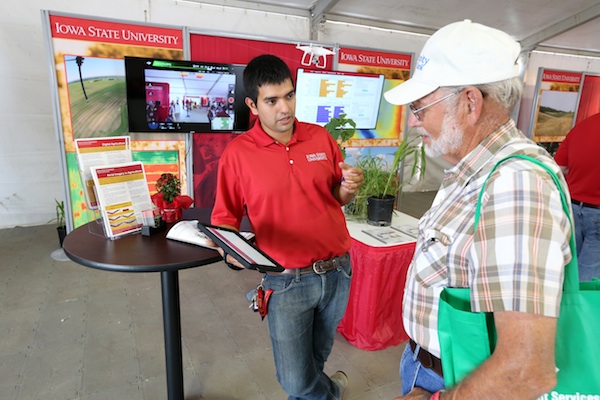
Birds-Eye View of Agriculture
Farmers make their livelihoods in the soil, but sometimes it takes a birds-eye view to evaluate a field. To that end, unmanned aerial vehicles (UAVs) are becoming an increasingly common sight hovering over Iowa’s corn and soybean fields, offering producers a big-picture view of their crops.
Matt Darr, an associate professor of agricultural and biosystems engineering at Iowa State University, called UAVs a “bleeding-edge technology” with great potential in agriculture. And faculty and students at Iowa State are playing a multifaceted role in advancing this emerging technology, he says.
Iowa State engineers are developing software to make UAVs smarter and faster at processing data, and Iowa State faculty are helping students and producers acquaint themselves with what the technology can do in the here and now.
The technology has the potential to give farmers a whole new perspective on their operations—from above.
If corn and soybean producers received grades like college students, their yields at the end of a growing season would amount to a final exam. Darr says UAVs offer farmers the opportunity to take the equivalent of midterm exams earlier in the growing season and make adjustments if necessary.
“Yield monitoring has been a good report card for 20 years, but you only get the data at the end of the season,” he says. “UAVs allow you to quantitatively assess crops throughout the year. It’s a better report card.”
Mark Licht, an assistant professor of agronomy, says unmanned aerial vehicles can scout a field in a fraction of the time it would take to walk the same acres.
The UAVs, typically lightweight quad- copters capable of staying in the air for up to 30 minutes, transmit photos or videos that allow the operator to view large swaths of land. The top-down view makes it easier to spot variation among crops that might be harder to see on foot or from the road, Licht says.
“I think the best use we have for UAVs right now is crop scouting,” he says. “We can go out to areas of a field that are performing well and compare them with areas that are performing poorly, and you don’t have to spend as much time in the field. From above, you can see patterns more easily.”
Darr says using a UAV to conduct an early season crop assessment gives farmers another important data point to add to their yield monitoring.
“We want every seed to have an equal chance to mature, but it’s really hard to assess whether that’s happening without quality data,” he says.
Flying into the future
While unmanned vehicles can already help with crop scouting, Darr says the future looks even brighter for the technology. Current models can gather images, but it still requires a human to sift through them and reach conclusions based on the images.
Darr says the next step in agricultural UAV development will feature smarter software and higher-resolution instruments that will give a more precise diagnosis of what’s happening in a particular field. To illustrate his point, Darr predicted future UAVs will be able to identify sections of field with insufficient nitrogen or a range of other deficiencies.
“Today, they’re a tool. The next step is to make UAVs a solution in their own right,” he says.
Part of that process is taking place at Iowa State, where faculty are working across disciplines and with graduate students to design the sort of advanced software it’ll take to power Darr’s vision.
Progress is occurring in the classroom too, where Iowa State students are receiving instruction on the potential of UAVs and the importance of analyzing the images and data they may capture. Darr says students get excited to work with innovative technology like UAVs. He says Iowa State faculty are tapping into that excitement to demonstrate to students the importance of applying data analysis to real-world farm management practices.
A new perspective
Sean Blomgren, a seed salesman who lives near Ames, conducts UAV flights for clients to help them survey their fields. Blomgren says he knows of
only a handful of producers who have purchased their own UAVs, but he says the technology has caught on with seed and equipment dealers, agronomists and other service-oriented sectors ofthe agricultural economy.
Blomgren says most farmers immediately recognize the value of scouting a field with a UAV once they see the top-down view the technology provides. It’s a difficult perspective to get by any other means, he says.
“They love their farms,” Blomgren says. “Their eyes light up when you show them a farm from an angle they’ve never seen before.”
Darr says the outreach component of Iowa State’s land-grant heritage means Iowa State University personnel are helping producers get the most out of the technology by showing them best practices and educating them on safety and what sort of options are available on the UAV market. Between developing the next iteration of UAV technology, teaching students how to use it and helping farmers get the most value from it, UAVs fit well with Iowa State’s mission.
And Licht says he sees growth on the horizon both for how commonly UAVs are used and what functions they can perform.
“I think they’re probably here to stay, but we’re going to evolve in how we’re using them,” he says.
When it comes to the future of UAVs in agriculture, it’s tempting to say the sky’s the limit.



